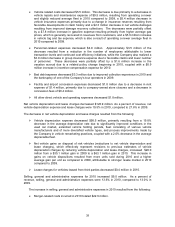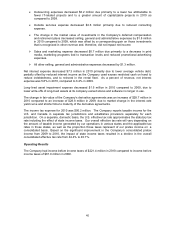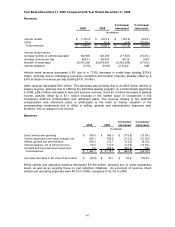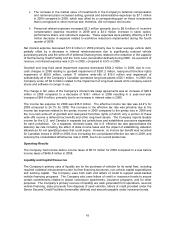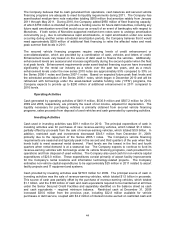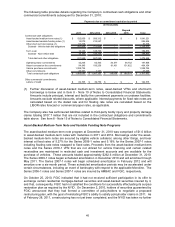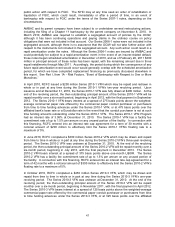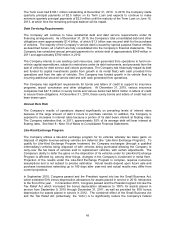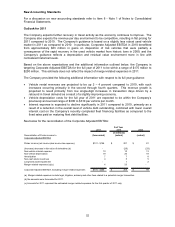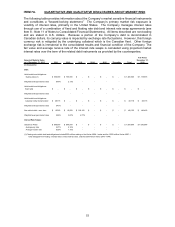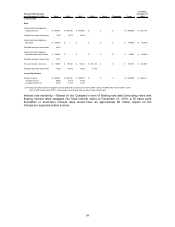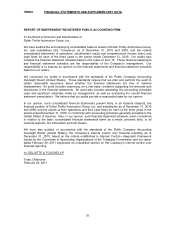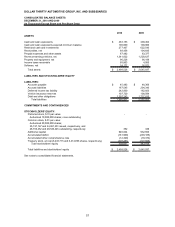Thrifty Car Rental 2010 Annual Report Download - page 50
Download and view the complete annual report
Please find page 50 of the 2010 Thrifty Car Rental annual report below. You can navigate through the pages in the report by either clicking on the pages listed below, or by using the keyword search tool below to find specific information within the annual report.The Term Loan had $148.1 million outstanding at December 31, 2010. In 2010, the Company made
quarterly principal payments of $2.5 million on its Term Loan and expects to continue to make
minimum quarterly principal payments of $2.5 million until the maturity of the Term Loan on June 15,
2013, at which time the remaining principal balance will be repaid.
Debt Servicing Requirements
The Company will continue to have substantial debt and debt service requirements under its
financing arrangements. As of December 31, 2010, the Company’s total consolidated debt and other
obligations were approximately $1.4 billion, of which $1.3 billion was secured debt for the purchase
of vehicles. The majority of the Company’s vehicle debt is issued by special purpose finance entities
as described herein, all of which are fully consolidated into the Company’s financial statements. The
Company has scheduled annual principal payments for vehicle debt of approximately $549 million in
2011 and approximately $700 million in 2012.
The Company intends to use existing cash resources, cash generated from operations to fund non-
vehicle capital expenditures, subject to restrictions under its debt instruments, and proceeds from the
sale of vehicles for debt service and vehicle purchases. The Company has historically repaid its debt
and funded its capital investments (aside from growth in its rental fleet) with cash provided from
operations and from the sale of vehicles. The Company has funded growth in its vehicle fleet by
incurring additional secured vehicle debt and with cash generated from operations.
The Company has significant requirements for bonds and letters of credit to support its insurance
programs, airport concession and other obligations. At December 31, 2010, various insurance
companies had $47.5 million in surety bonds and various banks had $68.5 million in letters of credit
to secure these obligations. At December 31, 2010, these surety bonds and letters of credit had not
been drawn upon.
Interest Rate Risk
The Company’s results of operations depend significantly on prevailing levels of interest rates
because of the large amount of debt it incurs to purchase vehicles. In addition, the Company is
exposed to increases in interest rates because a portion of its debt bears interest at floating rates.
The Company estimates that, in 2011, approximately 55% of its average debt will bear interest at
floating rates. See Item 8 - Note 10 of Notes to Consolidated Financial Statements.
Like-Kind Exchange Program
The Company utilizes a like-kind exchange program for its vehicles whereby tax basis gains on
disposal of eligible revenue-earning vehicles are deferred (the “Like-Kind Exchange Program”). To
qualify for Like-Kind Exchange Program treatment, the Company exchanges (through a qualified
intermediary) vehicles being disposed of with vehicles being purchased allowing the Company to
carry-over the tax basis of vehicles sold to replacement vehicles, with certain adjustments. The
Company’s ability to defer the gains on the disposition of its vehicles under its Like-Kind Exchange
Program is affected by, among other things, changes in the Company’s investment in rental fleet.
Projection of the results under the Like-Kind Exchange Program is complex, requires numerous
assumptions and is not subject to precise estimation. Actual results depend upon future sale and
purchase transactions extending up to 180 days after year-end and actual results may differ from
current projections.
In September 2010, Congress passed and the President signed into law the Small Business Act,
which extended 50% bonus depreciation allowances for assets placed in service in 2010, retroactive
to the first of the year. In December 2010, Congress passed and the President signed into law the
Tax Relief Act which increased the bonus depreciation allowance to 100% for assets placed in
service from September 9, 2010 through December 31, 2011, as well as provided for 50% bonus
depreciation for assets placed in service in 2012. The combined effect of the Small Business Act
and the Tax Relief Act (collectively, the “Acts”) is to significantly reduce the Company’s federal
49


